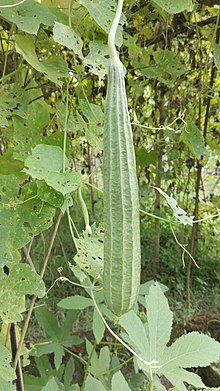Luffa acutangula
| Luffa acutangula | |
|---|---|

| |
| Scientific classification | |
| Kingdom: | Plantae |
| Clade: | Tracheophytes |
| Clade: | Angiosperms |
| Clade: | Eudicots |
| Clade: | Rosids |
| Order: | Cucurbitales |
| Family: | Cucurbitaceae |
| Genus: | Luffa |
| Species: | L. acutangula
|
| Binomial name | |
| Luffa acutangula | |
| Synonyms[1] | |
|
List
| |
Luffa acutangula is a cucurbitaceous vine that is commercially grown for its unripe fruits as a vegetable. Mature fruits are used as natural cleaning sponges. Its fruit slightly resembles a cucumber or zucchini with ridges. It is native to South Asia and has been naturalised in other regions.[1] It is also grown as a houseplant in places with colder climates. English common names include angled luffa, Chinese okra, dish cloth gourd, ridged gourd, sponge gourd, vegetable gourd, strainer vine, ribbed loofah, silky gourd, silk gourd,[2]
Uses
[edit]The young fruit of some Luffa cultivars are used as cooked vegetables or pickled or eaten raw, and the shoots and flowers are sometimes also used.[3] Like Luffa aegyptiaca, the mature fruits are harvested when dry and processed to remove all but the fruit fibre, which can then be used as a sponge or as fibre for making hats.[3]
Gallery
[edit]-
Extrafloral nectar glands[4] with Oecophylla smaragdina ants
-
Female flower
-
Male flower
See also
[edit]References
[edit]- ^ a b c "Luffa acutangula". Plants of the World Online. Royal Botanic Gardens, Kew. Retrieved 2024-02-27.
- ^ M.M.P.N.D. - Sorting Luffa names. Plantnames.unimelb.edu.au (2000-02-06). Retrieved on 2014-05-26.
- ^ a b Grubben, G.J.H.; Africa, P.R.o.T. (2004). Vegetables. Backhuys. ISBN 9789057821479.
- ^ Chakravarty, H. L. (October 1948). "Extrafloral Glands of Cucurbitaceæ". Nature. 162 (4119): 576–577. Bibcode:1948Natur.162..576C. doi:10.1038/162576b0. S2CID 4128826.

![Extrafloral nectar glands[4] with Oecophylla smaragdina ants](http://up.wiki.x.io/wikipedia/commons/thumb/7/7e/Glands_in_probract_that_attract_ants.jpg/71px-Glands_in_probract_that_attract_ants.jpg)

